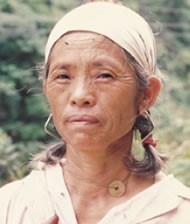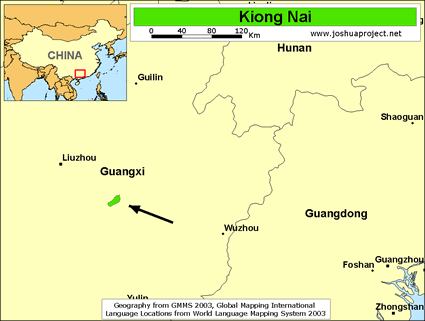Although they are officially (and ethnically) considered part of the Yao nationality, the Kiong Nai speak a language related to Miao. Kiong Nai is the selfname of this small tribe. The Chinese call them Hualan Yao which means "flowery blue Yao." It can also mean "Yao with baskets of flowers."
The Kiong Nai live alongside the Iu Mien and Lakkia in the Dayaoshan Mountains. These groups migrated into the area at different times. The Kiong Nai's homes are "built with brick and wood.... The Pan [Iu Mien] and Shanzi Yao [Kim Mun], however, had no land in the Dayaoshan, suggesting that these two groups were later arrivals in the area. They had to ask to use land from the three established Yao groups and had to pay rent and render manual labor to them. These two groups could not settle down but lived in rustic bamboo sheds."
Kiong Nai women wear beautiful dress, which is "embroidered with fine lace and consists of three wraps, one large, one smaller, and one a medium size.... A small bamboo basket is carried on the back and a long knife at the waist. A pair of short pants and a puttee completes the outfit." The Kiong Nai are renowned throughout the area for their skill in making silver ornaments.
The Kiong Nai are polytheists. They worship a variety of gods and spirits. Their religion has made them indifferent to the sanctity of human life. "It is their custom... to control the size of their population. They plan their families according to their wealth and the size of the land they will till. Generally, there will be one or two children in a family. In order to maintain their living standard, they do not hesitate to resort to abortion if and when their planning goes wrong."
The Kiong Nai people need better medical facilities in their part of China.
Pray for the Kiong Nai Church to experience a Holy Spirit led revival that will give them the desire to take Christ to others.
Pray for the Lord to bless them in such a way they will know he is powerful and loving.
Pray for the Holy Spirit to convict them of the sin of abortion.
Scripture Prayers for the Kiong Nai in China.
Operation China, Asia Harvest, Copyrighted © Used with permission
| Profile Source: Joshua Project |











